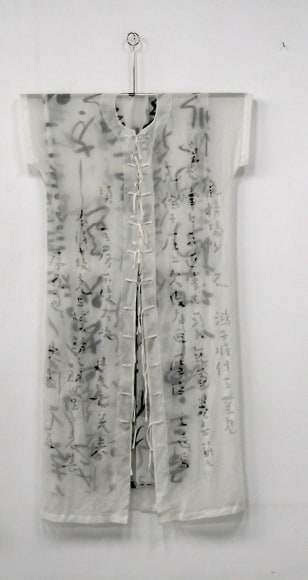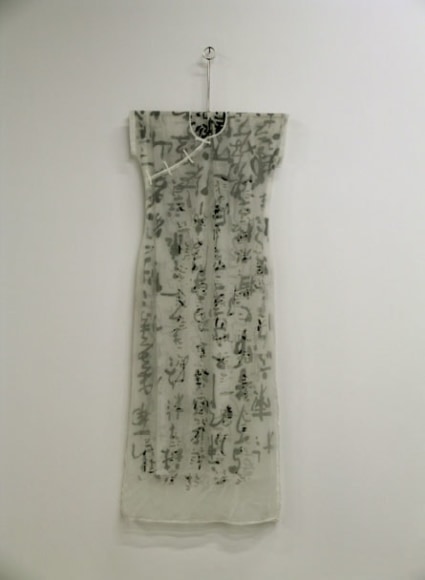Born in Shanghai in 1960, Wang Tiande graduated from the Zhejiang Academy of Fine Arts in 1988. While many young artists turned to Western models for inspiration during this period in which the political and artistic legacy of Mao Tse Tung was being increasingly questioned, a significant number of young artists including Gu Wenda, Xu Bing and Wang Tiande pursued the same goal while working within and subverting traditional Chinese modes of expression. Wang Tiande has said: "I was cut off for years from the west, and developed my craft in relative isolation. I struggled to find creative inspiration from deeply rooted traditions. While my friends turned to oil painting, I redefined ink painting and calligraphy, the most value-laden of China 's art forms."
After a series of works in the early 1990s in which he investigated the formal and symbolic possibilities of a circular format - the Round Series - Wang Tiande frequently used traditional Chinese motifs such as the fan and Chinese robes as the format for works in which the traditional technique of ink painting is radically transformed. Not satisfied with the smooth, absorbent surface of pristine sheets of paper, he has submitted the hallowed material to various abuses, including creasing, tearing and burning. Such virtuosity results in surface of unparalleled suggestive power, simultaneously suggesting the continuing presence of idealized landscape in the Chinese imagination and the destructive forces of modern civilization.
Wang Tiande first came to the attention of American collectors in 1998 when his installation Ink Banquet was included in the ground breaking exhibition of Chinese contemporary art, Inside Out, held at Asia Society and PS1. In this installation a round table set for a banquet surrounded by chairs was completely covered in ink-splashed paper. Moving beyond the rugged surfaces of his two-dimensional works, Wang transformed objects from the real world into strangely hybrid forms.
The current exhibition at Chambers Fine Art includes works from two new series, the Digital Series of 2002 and The Chinese Robe Series of 2003. In the former calligraphic inscriptions executed in running script are glimpsed through Chinese hand-made paper, the surface of which is inscribed with abstract forms burnt into the material. In the latter, the hanging robes are used as the surface for calligraphic gestures. Associated with the traditional culture of China that was swept away by the Cultural Revolution, the robe form is used as the bearer of barely legible messages that reveal its tenuous position in the technologically advanced China of the twenty-first century.
*Catalogue Available
《天德制造》是艺术家王天德在前波画廊举办的第一次个展。王天德出生于1960年,1988年毕业于浙江美术学院(现名中国美术学院)。八十年代中期时,人们逐渐开始怀疑毛泽东时期留下的政治和艺术遗产,许多年青的艺术家开始从西方艺术中寻找灵感。其他艺术家以中国传统艺术为基础,其中最具典型性的几位艺术家包括谷文达, 徐冰和王天德,用不同的表达形式追求着相同的目标。王天德说过:“我多年来一直和西方世界隔离,独自一人发展。在传统中挣扎,寻找创作灵感。当我的朋友们转向油画时,我却重新定义水墨画和书法这些最有价值的中国艺术形式。在坚持运用水墨时,你必须非常努力才会避免倒退到保守。”
自九十年代早期起,王天德创作了一系列具有传统象徵意义的圆形作品─《圆系列》─屡次运用中国的传统主题。例如以扇子和中国服饰为创作原料,从根本上转化了传统水墨画的技术。被摺叠和摩擦过的纸张,与传统的光滑及吸水的表面截然不同。被毁损的纸面因吸收了水墨而变得完整,他作品中的宣纸虽然从未直接表现,但却隐喻着自然和山水在中国现代文化中的逐渐灭亡。
1998年在亚洲协会(Asia Society)和纽约PSI当代美术馆举办的《新中国艺术展─蜕变》展览中,王天德的艺术生涯得到突破,第一次受到了美国收藏家的关注。他在这次展览中展出了一张大的餐桌,八张椅子和餐具,全部都被水墨覆盖。在平面作品中,他把现实世界的平凡物品,转变成为混合陌生不被认知的方式。
这次在前波画廊的展览包括两个系列:《数码系列》和《2002和中国服饰-F》。在《数码系列》中,一些附有无规则的燃烧印迹的宣纸下,有另一张宣纸,纸上写有书法符号。燃烧的烟灰落到宣纸上时,一个全新的空间随之产生。在《中国服饰-F》中,悬挂的旗袍被用作书法的表面,从而引申为在文化大革命中被清除的中国传统。旗袍传达的信息清楚地揭示了中国传统在高科技的二十一世纪的微弱地位。
*前波画廊为此展览出版了展览图录




